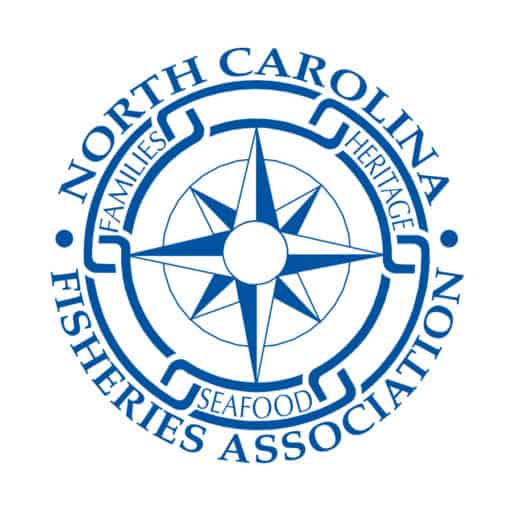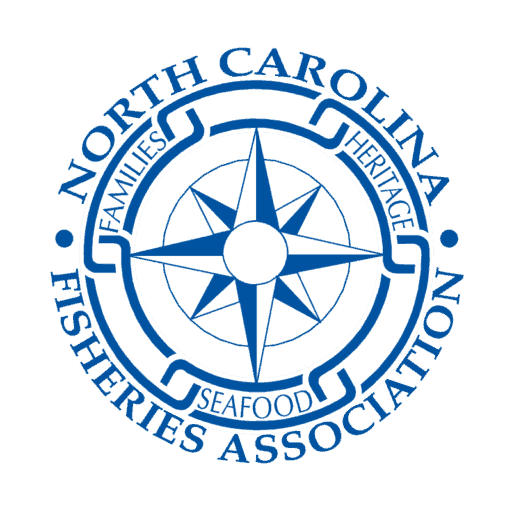The following public comments were sent to several members of the NC Marine Fisheries Commission by Glenn Skinner, Executive Director of the NCFA.
Commissioners,
I’d like to offer the following comments in regards to the Striped Mullet Supplement which is up for your final approval at next week’s MFC meeting.
I have some serious concerns with both your willingness to adopt a supplement to Amendment 1 of the Striped Mullet FMP and the data presented by the Division to support this action. Let me start by saying that, in the past, a supplement has been viewed as an emergency management measure to be used when the available data suggests that waiting for the completion of the amendment process to implement a long-term management strategy could jeopardize the long-term viability of a fishery. This said, when determining whether a supplement is justified you should first look closely at the available data to determine whether a true “emergency” that jeopardizes the long-term viability of this fishery actually exists.
Does it?
In my opinion the answer is clearly no. As you know, the sole source of data used, in the striped mullet stock assessment, for determining abundance was the Independent Gill Net Survey (Program 915), which the Division acknowledges has its limitations. In section 2.2.2.4 Potential Biases and Uncertainties, of the stock assessment, the Division states that, ” Although Striped mullet are considered a target species, this program (Program 915) was not designed to specifically target Striped Mullet. The sampling effort is designed to gather data on fishes using the estuarine habitats but does not account for nearshore ocean and offshore ocean populations. Also, the range of gill-net sizes used in this survey will exclude the smallest individuals. This survey does not sample the many shallow creeks and tributaries off the main river stems, habitats that are frequently used by Striped Mullet.”
I understand the need for random independent sampling when trying to determine Catch Per Unit of Effort (CPUE) but when the survey methodology, gear used, or method of deploying the gear is not “designed to specifically target” the species in question the variability in the data may be a result of inadequate survey methods rather than true abundance.
The limitations of the 915 survey paired with recent management actions could also explain the decreased observation of older fish contributing to the appearance of truncated age structure within the Striped Mullet stock. Adult mullet, like many fish species, prefer higher salinity habitats near inlets and in the ocean waters making them less susceptible to the limited 915 survey. This fact paired with years of harsh restrictions limiting the use of large mesh gill nets, which are more likely to catch the larger, presumably older, mullet would certainly explain decreasing encounters with older fish. Simply put, the limitations of the independent sampling and other management actions, taken by the Commission, could have resulted in data limitations resulting in imprecise estimates of SSB increasing the uncertainty with the current stock assessment.
This uncertainty doesn’t mean you shouldn’t manage this fishery but it does cast some doubt on whether emergency measures are necessary.
Many have suggested that declines in commercial harvests of Striped Mullet support the stock assessments “overfished and overfishing is occurring” determination and lend validity to the independent data, but after looking closely at the data I disagree.
I’ve looked closely at the last 50 years of harvest data on the DMF website and the commercial harvest of Striped Mullet varied quite a bit over the entire time series with what appears to be a declining trend in recent years. Normally a declining trend would cause concern, even for me, but something looked different with mullet harvest numbers. There were six consecutive years (2015-2020) of considerably low harvest, below 1.3 million pounds, with the lowest landings on record of 965,337 pounds in 2016, followed by a significant increase in harvest in 2021. This is the only 6 year period of consecutively low, or high, landings over the last 50 years suggesting a decline in abundance but it doesn’t make sense that landings would shoot back up to over 2 million pounds in 2021 with an overfished stock and ongoing overfishing occurring.
Does it?
Of course not, but what really happened? For the answer, all you have to do is look at shrimp harvest over that same time period. The 7-year period from 2015-2021 is the only time over the last 50 years when shrimp landings consecutively exceeded 9 million pounds for more than 2 years in a row. Those 7 years of high harvest were the direct result of unusually high landings in the white shrimp fishery which peaks in the fall coinciding with the peak harvest season for Striped Mullet.
Simply put, any fisherman who owned a shrimp boat or could get work on the deck of one went shrimping, shifting effort from the mullet fishery to the shrimp fishery resulting in decreased mullet landings and concerns for the stock!
It’s no coincidence that the only long-term period of unusually low mullet harvest, in the last 50 years, lines up perfectly with the only long-term period of unusually high shrimp landings, in the last 50 years. It can’t be!
There were also numerous tropical systems impacting NC during this time period which are known to impact the fall harvest season, the peak season for mullet landings. In fact, during 2016, which represented the lowest recorded landings over the last 50 years, we were impacted by four tropical systems between August 27 and October 9. These included Bonnie, Hermine, Julia, and of course Matthew which caused significant flooding and 25 deaths in NC. Fishermen have long known that a fall storm can spell disaster for critical fall fisheries like Southern Flounder and Striped Mullet and this is obvious in the data.
If this isn’t enough to convince you that the sky isn’t falling and that emergency management action is not warranted for the Striped Mullet fishery then consider this. The Division acknowledges “that abundance, (of striped mullet) observed in the Divisions sampling and harvest has increased over the last two years.” While I haven’t seen the data for 2022, from what I’ve seen on the water and heard from both recreational and commercial fishermen, I’d bet that increasing trend has continued and that alone shows there is no need for a supplement to this FMP. Expansion of the stock is not an emergency!
The Amendment process allows for a more in depth look at what’s actually occurring in this fishery, which is obviously needed, more stakeholder participation, and will give us all the opportunity to see the most recent data. I strongly recommend that you each resist the urge to implement this supplement which I view as little more than a knee jerk reaction to so called “overfishing” and choose to move forward with the amendment process and an open mind. If you have any questions or concerns don’t hesitate to reach out any time.
Thanks
—
Glenn Skinner
Executive Director-
North Carolina Fisheries Association, Inc.
101 N. 5th Street
Morehead City NC 28557
252-646-7742
The Striped Mullet Supplement
The North Carolina Marine Fisheries Commission (MFC) is meeting this week to vote on a supplement to the current Striped Mullet Fisheries Management Plan (FMP) which would close mullet harvest during the middle of the roe season.
At the November MFC meeting staff at the Division of Marine Fisheries (DMF) presented Supplement A to the Striped Mullet FMP. In Supplement A the DMF recommends a 20-33% reduction in mullet landings by closing the harvest season in late October or early November through December 31st for at least one year. The preferred option of a November 7th to December 31st closure was selected by the MFC at this meeting.
In December and January DMF held several public meetings giving people the opportunity to ask questions and give public comment on the end of season closure. Overwhelming public comment during these meetings suggests that mullet are not overfished and overfishing is not occurring. Definitely not to the extent that a 20-33% reduction in harvest is needed!
In fact, mullet abundance this past season seemed to be at a level not seen in decades! Many mullets left the sounds before the roe season and large numbers of mullets are still up the rivers right now. Furthermore, there is still plenty of time for the DMF to collect more data before this decision has to be made, if a closure is even necessary at all.
It is not too late to comment and tell the MFC why reducing the Striped Mullet season is not necessary.
Come out and be seen and heard!
Written comments are accepted until today (February 20th) at 4pm at this link:
https://deq.nc.gov/nc-marine-fisheries-commission-comment-form
You can also comment in person at the Doubletree Hotel in New Bern, NC Wednesday night at 6:00pm or Thursday morning at 9:00am at the meeting this week.
(Important to note, no online comments will be accepted during the live meeting comment session.)
The discussion and vote on the Striped Mullet Supplement will begin at approximately 2:30pm on Thursday (Feb. 23rd). Listen live on YouTube at this link once the meeting starts:
https://youtube.com/live/QNrjWEW11z8?feature=share
From my personal experience, the meeting streams much better on the YouTube app versus watching it from your web browser. You can download the YouTube app in the App Store or Google Play.
As always, contact me with any questions or if you need help accessing any of the meeting materials.
Thomas Newman
Fisheries Liaison
|
Release: Immediate |
Contact: Patricia Smith |
|
Date: Feb. 10, 2023 |
Phone: 252-726-7021 |
|
MEDIA ADVISORY: Marine Fisheries Commission to meet Feb. 22-24 in New BernMOREHEAD CITY – The N.C. Marine Fisheries Commission will meet in-person Feb. 22-24 at the DoubleTree by Hilton Hotel New Bern Riverfront, 100 Middle St., New Bern. The meeting will also be livestreamed on YouTube. The meeting will begin at 6 p.m. on Wednesday, Feb. 22, at 9 a.m. on Thursday, Feb. 23, and at 9 a.m. on Friday, Feb. 24. The commission will hold in-person public comment sessions at 6 p.m. Wednesday, Feb. 22, and near the beginning of the meeting on Thursday, Feb. 23. Public comment will not be taken through web conference.
The following information pertains to in-person public comment:
The public may also submit written comments via the following methods:
Written comments must be received by 4 p.m. Monday, Feb. 20. The YouTube link will be posted on the Marine Fisheries Commission Meetings webpage. After the meeting, a recording will be posted online. Agenda items include votes on the following:
The commission is also scheduled to receive presentations on false albacore, protected resources, and spotted seatrout, and an update on southern flounder.
The full agenda and briefing book are posted on the Marine Fisheries Commission Meetings webpage.
|
LEGISLATIVE UPDATE: 2.20.2023
GENERAL ASSEMBLY
The Joint Appropriations Committee for Agriculture, Natural and Economic Resources met again last week and during the presentation of the Department of Commerce, Bob Peele gave an overview of the Wanchese Marine Industrial Park. Time was limited so Bob couldn’t give a complete history of the park, so I suggested to him and Senator Norman Sanderson afterwards that at some point the legislators need to hear why the park was transformed from the Seafood Park to Marine Industrial Park. In other words, they need to hear how the seafood industry has fared over the course of several decades and why.
Several legislators mentioned they need our perspective on a number of issues, so I’ll be working on making appointments this week to see what’s on their minds.
God bless,
Jerry

